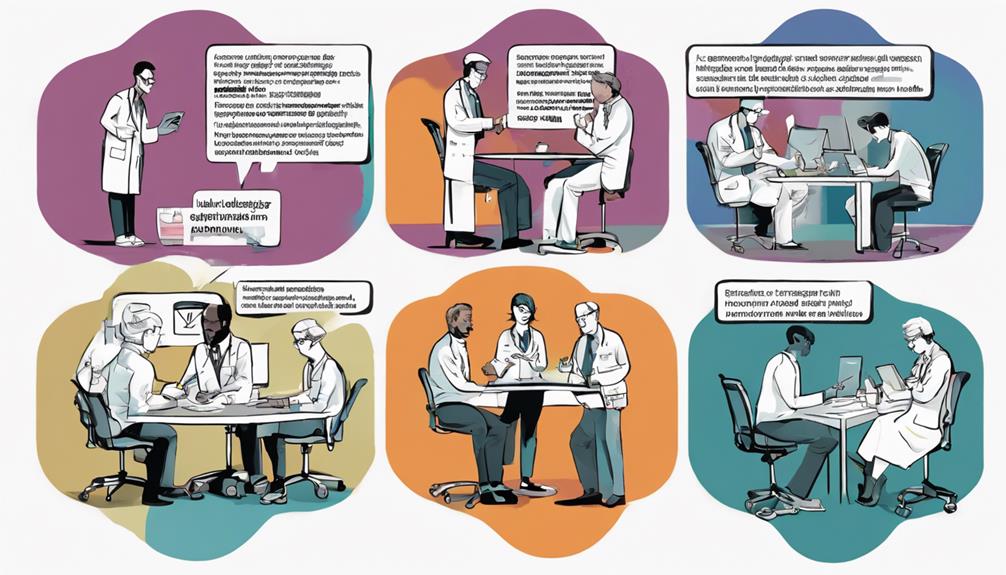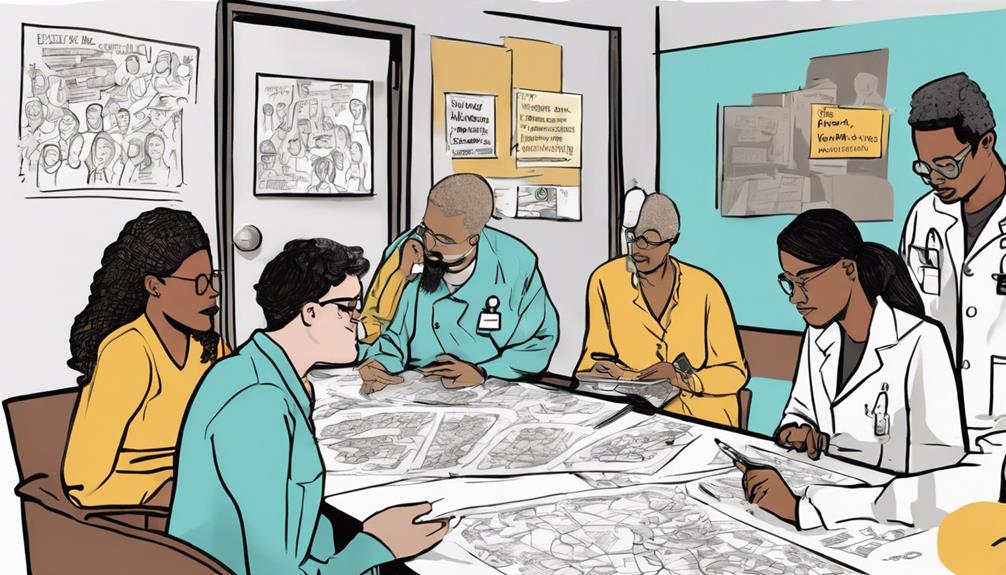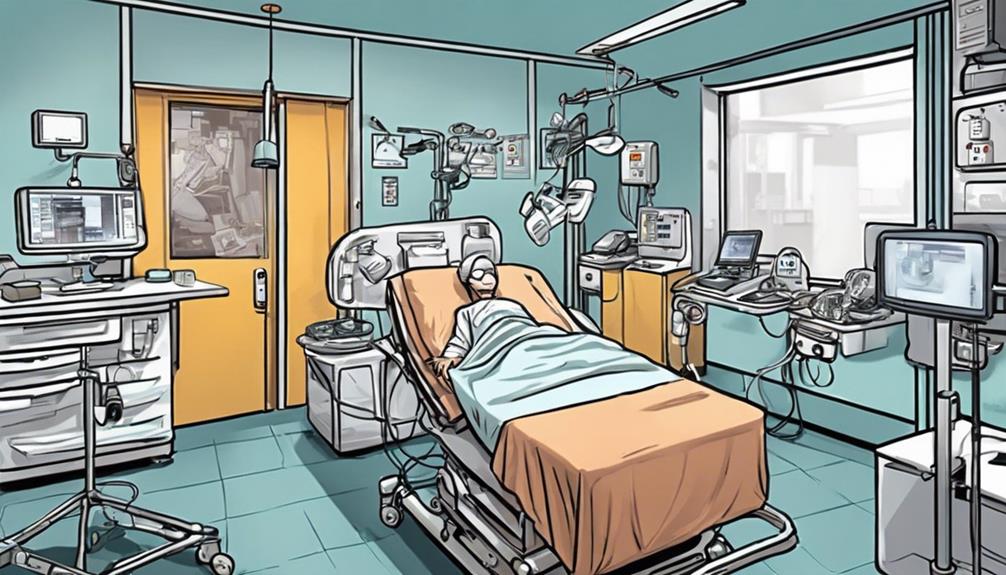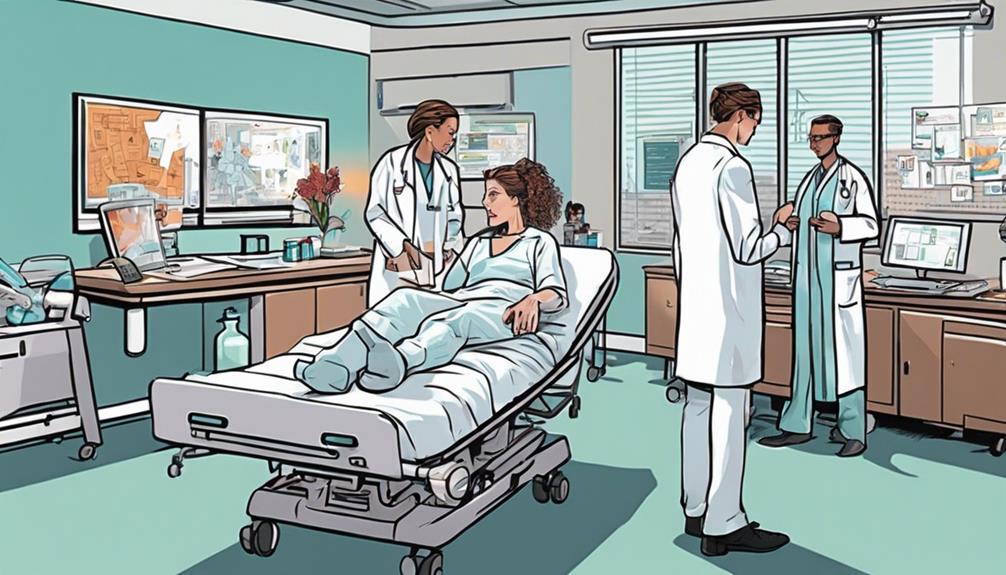Enhance healthcare outcomes by infusing innovation with design thinking principles. Centering solutions around patients leads to improved results. Integrating technology revolutionizes care delivery methods. Personalized approaches enhance clinical outcomes notably. Adopting design thinking fosters the creation of cutting-edge healthcare solutions that cater to diverse needs effectively.
Key Takeaways
- Design Thinking enhances patient outcomes through user-centered solutions.
- Technology integration revolutionizes care delivery for personalized solutions.
- Multidisciplinary collaboration fosters innovative healthcare products.
- Prioritizing user feedback bridges provider-patient gap for better engagement.
- Design Thinking leads to cost-efficient, tailored care delivery in healthcare.
Fundamentals of Design Thinking
Understanding the core principles of Design Thinking is essential for transforming healthcare practices. Design Thinking in healthcare focuses on creating user-centered solutions to enhance patient outcomes and drive innovation. By putting patients at the center of the design process, healthcare professionals can develop tailored solutions that address specific needs and improve overall experiences.
One key aspect of Design Thinking in healthcare is the integration of technology to revolutionize the delivery of care. By leveraging technological advancements, healthcare providers can create personalized solutions that cater to individual patient requirements. This not only enhances patient engagement but also leads to improved clinical outcomes and the development of innovative healthcare products.
Incorporating Design Thinking principles into healthcare practices can lead to significant advancements in the industry. By emphasizing empathy, defining problems, ideation, prototyping, and testing, healthcare professionals can overcome challenges, drive change, and ultimately provide better care for their patients.
Design Thinking Phases

How do the key phases of Design Thinking in healthcare contribute to the innovation process?
Design Thinking in healthcare follows a structured approach involving empathy, define, ideate, prototype, and test to guarantee solutions meet user needs effectively:
- Empathy:
The first phase emphasizes understanding user needs by immersing in their experiences and conducting thorough research.
- Define:
This step involves synthesizing gathered insights to define the core problem clearly, setting the direction for the innovation process.
- Ideate:
Through brainstorming sessions, creative idea generation is encouraged, followed by prioritization to select the most promising solutions.
- Prototype:
Building tangible solutions allows for testing with users, gathering feedback, and refining the idea iteratively to guarantee it aligns with user needs and expectations.
User-Centered Approach

In healthcare, a user-centered approach is pivotal for designing effective and tailored interventions. By focusing on understanding user needs, healthcare innovation can be significantly enhanced. This approach involves immersing yourself in users' environments, conducting interviews, and analyzing findings to tailor solutions to individual needs. Design Thinking promotes multidisciplinary collaboration, rapid prototyping, and iterative processes to create user-centric healthcare innovations. Prioritizing user preferences and feedback helps bridge the gap between healthcare providers and patients, ultimately leading to improved patient engagement, satisfaction, and trust in healthcare delivery.
| User-Centered Approach | Key Aspects | Benefits |
|---|---|---|
| Understanding User Needs | Immersion in user environments, Conducting interviews | Tailored solutions to individual needs |
| Healthcare Innovation | Multidisciplinary collaboration, Rapid prototyping | User-centric healthcare solutions |
| Patient Engagement | Prioritizing user feedback, Bridging provider-patient gap | Improved satisfaction and trust |
Implementation Challenges

Facing resistance from traditional practices and encountering resource constraints, implementing Design Thinking in healthcare presents significant challenges. To navigate these hurdles effectively, consider the following key points:
- Traditional Practices: Overcoming ingrained traditional healthcare practices and hierarchical structures is essential for successful implementation.
- Resource Constraints: Addressing limited budgets and the lack of dedicated design teams is crucial to drive design thinking initiatives forward.
- Integration with Existing Systems: Finding ways to harmonize design thinking with existing systems, including legacy technologies and regulatory requirements, is a crucial challenge.
- Measuring Impact and Scaling Initiatives: Defining success metrics, quantifying patient satisfaction, evaluating clinical outcomes, replicating successful models, training a larger workforce, and ensuring consistency in implementation are vital aspects when measuring impact and scaling design thinking initiatives in healthcare.
Design Thinking Tools

You're about to explore key Design Thinking tools that can revolutionize healthcare.
Prototyping will let you gather user feedback efficiently.
Ideation will spark creative solutions.
An overview of Implementation Tools will guide you through the process.
These tools are essential for crafting innovative and user-centered healthcare solutions.
Prototyping for User Feedback
When prototyping for user feedback in Design Thinking, creating low-fidelity models is essential to gather valuable insights for refining solutions. These models serve as a tangible representation of ideas, allowing for focused feedback from users.
Here's what you need to know about prototyping for user feedback:
- Low-Fidelity Models: Begin with simple and cost-effective prototypes to quickly test concepts and gather initial feedback.
- User Feedback: Engage users early and often to understand their preferences, pain points, and suggestions for improvement.
- Iterative Improvements: Use feedback from users to make incremental changes to prototypes, refining solutions with each iteration.
- High-Fidelity Testing: Progress to high-fidelity prototypes for final testing, ensuring that the solution meets user needs effectively.
Ideation for Creative Solutions
During ideation in Design Thinking, tools like brainstorming and mind mapping are utilized to foster the generation of creative solutions through divergent thinking. In this phase, the focus is on quantity over quality initially to explore a wide range of possibilities. It's vital to encourage wild ideas and diverse perspectives to push the boundaries of innovation.
To help you visualize the ideation process, here's a breakdown of some key tools used:
| Tool | Description | Purpose |
|---|---|---|
| Brainstorming | Releasing a flurry of ideas without judgment | Encouraging creativity and idea generation |
| Mind Mapping | Visual representation of interconnected ideas | Organizing and connecting thoughts logically |
| SCAMPER | Substitution, Combination, Adaptation, etc. | Stimulating creative thinking through prompts |
Implementation Tools Overview
To further advance the design process in healthcare, an overview of implementation tools in Design Thinking is necessary. Design Thinking tools play a vital role in the implementation of evidence-based and human-centered design solutions in healthcare innovation.
Here are four key aspects to keep in mind:
- Prototyping of Solutions: Utilizing techniques like brainstorming and mind mapping, healthcare professionals can create tangible prototypes to test and refine potential solutions.
- User-Centered Design: By incorporating feedback from patients and healthcare providers throughout the design process, solutions can be tailored to meet the specific needs of end-users.
- Promoting Creativity: Design Thinking tools encourage creative thinking, enabling innovative approaches to healthcare challenges.
- Collaborative Approach: These tools foster collaboration among multidisciplinary teams, leading to thorough and effective healthcare solutions.
Impact on Healthcare

Design Thinking in healthcare has a significant impact on patient engagement strategies by fostering trust and satisfaction.
It also plays a pivotal role in enhancing clinical outcomes through reduced medical errors and improved treatment adherence.
Additionally, Design Thinking drives innovation in healthcare products, ensuring user-friendly solutions and creative problem-solving approaches.
Patient Engagement Strategies
Engaging patients actively in their healthcare journey greatly influences the overall impact on healthcare outcomes and patient satisfaction. Patient engagement strategies play a pivotal role in improving healthcare delivery by fostering collaboration between patients and healthcare providers.
Here are some key points to keep in mind:
- Improved Patient Satisfaction: Patient engagement strategies lead to higher levels of patient satisfaction and trust in healthcare providers.
- Enhanced Clinical Outcomes: Effective patient engagement contributes to better treatment adherence and ultimately leads to improved clinical outcomes.
- Tailored Care Delivery: By tailoring care to individual patient needs, engagement strategies facilitate better disease management and overall health outcomes.
- Cost-Efficient Healthcare: Empowering patients in decision-making not only enhances their engagement but also contributes to cost-efficient healthcare delivery.
Incorporating design thinking and patient-centered care principles into patient engagement strategies fosters innovation in healthcare and promotes flexibility in care delivery models to meet the evolving needs of patients.
Clinical Outcomes Enhancement
In healthcare, focusing on enhancing clinical outcomes has a direct impact on improving patient satisfaction and overall healthcare delivery. By utilizing Design Thinking principles, healthcare providers can reduce medical errors, improve treatment adherence, and ultimately enhance patient outcomes.
Patient engagement plays an essential role in this process, as fostering trust and collaboration between patients and providers leads to better adherence to treatment plans and overall improved health outcomes.
Moreover, through innovative approaches driven by Design Thinking, healthcare products and services become more user-friendly and efficient, ultimately benefiting both patients and healthcare providers. This innovation not only enhances clinical outcomes but also contributes to cost-efficiency in healthcare delivery by optimizing resource allocation and streamlining care processes.
Additionally, the adaptability that Design Thinking offers allows healthcare systems to respond effectively to evolving patient needs and technological advancements, ensuring that the delivery of healthcare remains effective and patient-centered.
Healthcare Product Innovation
Enhancing healthcare through product innovation has a significant impact on patient outcomes and overall healthcare quality. When design thinking is applied to healthcare product innovation, it transforms the patient experience by addressing specific patient needs and creating solutions with improved design.
Here are four key ways healthcare product innovation influences the healthcare landscape:
- Enhanced Patient Experience: Healthcare products developed through design thinking prioritize the patient's journey, leading to increased engagement and satisfaction.
- Improved Clinical Outcomes: Design thinking in healthcare results in user-centered solutions that have a positive impact on clinical results and patient well-being.
- Better Disease Management: Innovative healthcare products help patients manage their conditions more effectively, promoting better health outcomes.
- Cost-Efficiency: By embracing design thinking-driven solutions, healthcare providers can streamline processes, reduce waste, and deliver quality care in a more cost-effective manner.
Technology Integration

Integrating technology in healthcare through design thinking transforms patient care delivery and experience. By leveraging cutting-edge technologies like mobile apps and wearable devices, healthcare providers can enhance patient engagement and deliver more personalized care.
Through design thinking, innovative solutions such as Philips' medical devices and SwipeSense for hospital infections have been developed, revolutionizing the way healthcare is managed and delivered.
However, challenges in technology integration persist, including the need to align with regulatory requirements and smoothly shift from traditional systems. Despite these obstacles, opportunities for growth abound.
By deepening the understanding of user needs and expanding innovation at the intersection of technology and user experience, the healthcare industry can continue to evolve and improve patient outcomes.
Embracing technology integration through design thinking is key to driving advancements in healthcare management and ultimately enhancing the overall patient experience.
Future Research Directions

Exploring potential research avenues for Design Thinking in healthcare must prioritize measuring long-term impacts on patient outcomes and cost-efficiency. To guide your future investigations, consider the following key areas:
- User Needs: Investigate to understand the specific needs and preferences of patients, healthcare providers, and other stakeholders to tailor Design Thinking solutions effectively.
- Healthcare Innovation: Focus on fostering a culture of continuous innovation within healthcare organizations through Design Thinking methodologies to drive positive change.
- Long-Term Impact: Evaluate the sustained effects of implementing Design Thinking approaches on patient outcomes and overall cost savings to ensure lasting benefits.
- Scalability: Explore strategies to scale Design Thinking initiatives across diverse healthcare settings to maximize impact and reach a broader patient population.
Regulatory Considerations

Managing regulatory considerations is vital when implementing Design Thinking in healthcare to guarantee compliance and successful outcomes. In the USA, the FDA serves as the primary regulatory body overseeing medical devices, making adherence to their guidelines crucial for innovation in healthcare. Design thinkers must also address commercial viability to ensure that their solutions can be effectively implemented in real-world settings.
Moreover, the lack of standards in reporting health research that incorporates design thinking poses challenges for evaluating the impact and effectiveness of these innovative solutions. This gap highlights the importance of establishing clear reporting protocols to accurately gauge the outcomes of design-driven healthcare interventions.
Additionally, the clash between design and health sciences traditions can create obstacles for analyzing the effectiveness and safety of new healthcare approaches. Hence, bridging these disciplines is critical for driving meaningful innovation in the healthcare sector.
Healthcare Innovation Solutions

Enhancing healthcare through innovative solutions driven by Design Thinking involves prioritizing user needs and feedback for effective interventions. When it comes to healthcare innovation solutions, Design Thinking offers a transformative approach that benefits both healthcare providers and patients.
Here are four key aspects to contemplate:
- User-Centric Approach: Design Thinking in healthcare puts patient needs at the forefront, ensuring that solutions are tailored to enhance patient experiences and outcomes.
- Innovative Solutions: By incorporating Design Thinking methodologies, healthcare providers can develop cutting-edge and user-friendly medical devices that revolutionize patient care.
- Problem-Solving Strategies: Design Thinking fosters creative problem-solving approaches that address complex healthcare challenges effectively and efficiently.
- Integration of Technology: The integration of technology with Design Thinking leads to the creation of personalized and efficient healthcare solutions, ultimately improving the quality of care delivery.
Frequently Asked Questions
What Is the Role of Design Thinking in the Improvement of Healthcare Services?
In improving healthcare services, design thinking plays an essential role by focusing on user needs, feedback, and rapid prototyping. It enhances innovation, efficiency, and effectiveness through empathy, collaboration, and an iterative problem-solving process.
How Do You Implement Innovation in Healthcare?
To implement innovation in healthcare, you prioritize user needs, collaborate with professionals, and leverage technology. Overcoming resistance and resource constraints is key. Revolutionize patient care by integrating design thinking with technology for human-centered solutions.
Why Is Innovation and Creativity Important in Healthcare?
You know, in healthcare, innovation and creativity are like a spark that lights up the path to better patient care and outcomes. They pave the way for cost savings, efficiency gains, and patient-centered solutions.
Why Is Digital Innovation Important in Healthcare?
Digital innovation is essential in healthcare for improving patient outcomes, enhancing access to care, and reducing costs. By embracing technology like telehealth and data analytics, you can streamline operations, empower patients, and drive continuous improvement.
Conclusion
So, you've learned all about design thinking in healthcare and how it can revolutionize the industry.
But remember, innovation doesn't come easy. It takes time, effort, and a willingness to challenge the status quo.
So go ahead, immerse yourself in the world of healthcare innovation with design thinking, but don't expect it to be a walk in the park.
Embrace the challenges and push the boundaries of what's possible in healthcare.
Who knows what amazing solutions you'll come up with!









